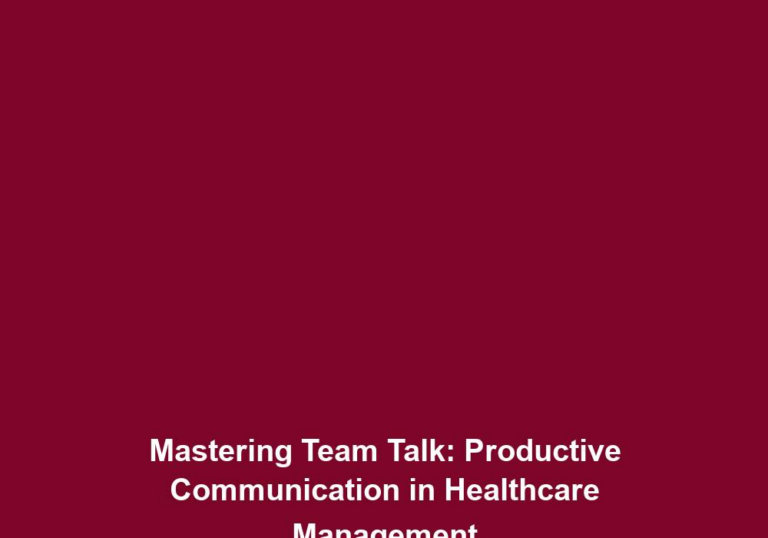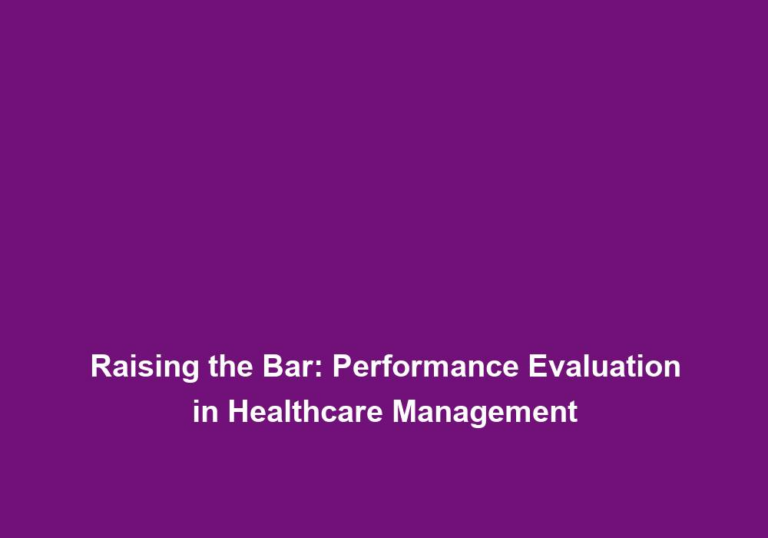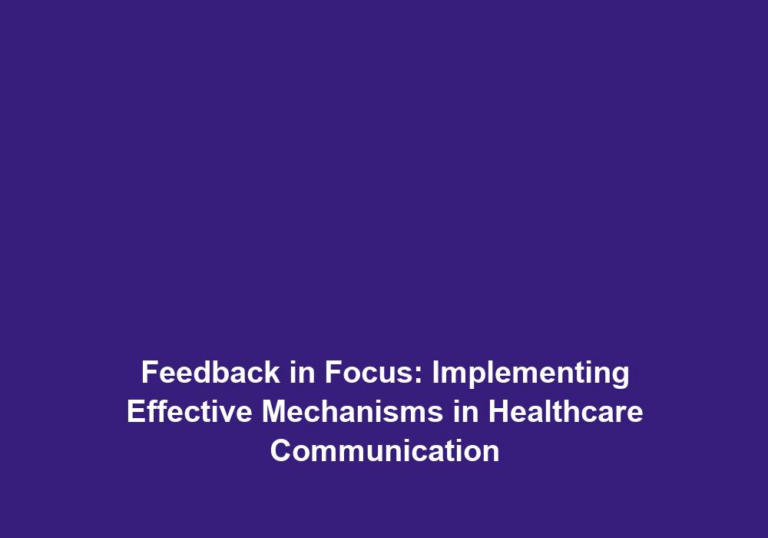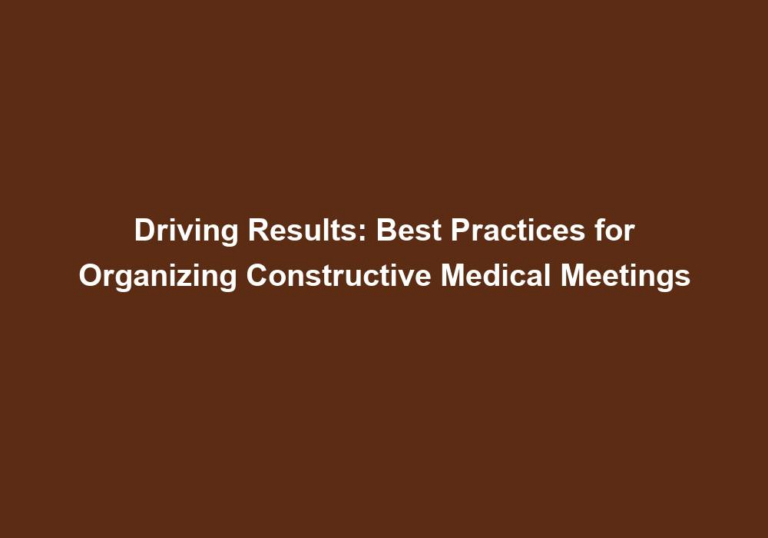Mobilizing Medical Minds: Organizing Efficient and Constructive Meetings
In the fast-paced world of medicine, effective communication and collaboration are vital for advancing patient care and driving medical research. Medical professionals often come together for meetings to discuss important topics, share knowledge, and make critical decisions. However, without proper organization and structure, these meetings can become unproductive and time-consuming. This is where strategic planning and efficient execution come into play. In this article, we will explore the key elements of organizing efficient and constructive meetings in the medical field.
Importance of Well-Structured Meetings
Effective meetings serve as a platform for medical professionals to exchange ideas, brainstorm innovative solutions, and foster professional relationships. Well-structured meetings can lead to increased productivity, improved decision-making, and enhanced collaboration among healthcare professionals. Let’s delve into the importance of well-structured meetings and how they can benefit medical organizations:
-
Increased Productivity: Well-structured meetings help keep discussions focused and on track, minimizing unnecessary tangents and wasted time. By setting clear objectives and following a well-defined agenda, participants can stay engaged and contribute meaningfully to the meeting’s goals.
-
Improved Decision-Making: Structured meetings provide a framework for thorough discussions and evaluations of potential solutions or courses of action. By encouraging active participation and considering diverse perspectives, medical professionals can make informed decisions that have a positive impact on patient care.
-
Enhanced Collaboration: Organizing efficient meetings fosters collaboration among healthcare professionals from different specialties and backgrounds. By creating an environment where everyone feels comfortable sharing their insights and engaging in constructive debates, medical organizations can harness the collective intelligence of the group and drive advancements in the healthcare industry.
Preparing for a Successful Meeting
Set Clear Objectives and Agenda
Before scheduling a meeting, it is essential to define clear objectives and establish an agenda. Determine the purpose of the meeting and identify the specific topics that need to be addressed. By setting clear objectives and creating an agenda, you provide attendees with a clear understanding of what the meeting aims to achieve, allowing them to come prepared and contribute meaningfully.
Consider the following tips when setting clear objectives and creating an agenda:
-
Define the Meeting’s Purpose: Clearly articulate the main goal or objective of the meeting. Is it to discuss a specific issue, brainstorm solutions, or make important decisions? Defining the purpose will help guide the discussions and keep participants focused.
-
Identify Key Topics: Identify the specific topics or agenda items that need to be addressed during the meeting. Break them down into manageable segments to ensure sufficient time for discussion and decision-making.
-
Prioritize Agenda Items: Arrange the agenda items in order of importance or urgency. This will help allocate appropriate time and ensure that critical topics receive the necessary attention.
Invite the Right Participants
Inviting the right participants is crucial for the success of any meeting. Ensure that the individuals attending have a direct stake in the topics being discussed or possess the expertise and knowledge necessary to contribute meaningfully. Keeping the group size manageable can also help maintain focus and foster productive discussions.
Consider the following when inviting participants:
-
Direct Stakeholders: Identify individuals who have a direct interest or involvement in the topics being discussed. These may include medical professionals, researchers, administrators, or relevant stakeholders from other departments.
-
Expertise and Knowledge: Invite participants who possess the expertise and knowledge required to contribute meaningfully to the discussions. Consider the different perspectives and specialties that can add value to the meeting’s objectives.
-
Manageable Group Size: Keep the group size manageable to ensure effective communication and participation. Large groups may lead to less engagement and difficulty in facilitating productive discussions.
Provide Pre-Reading Material
To maximize the effectiveness of the meeting, provide pre-reading material to participants. This allows them to familiarize themselves with the topics and come prepared with informed opinions and ideas. Pre-reading materials can include relevant research papers, reports, or even summaries of previous meetings to provide context and background information.
Consider the following when providing pre-reading material:
-
Relevant Resources: Select resources that are directly related to the meeting’s topics and objectives. Ensure that the materials are concise, easy to understand, and provide valuable insights.
-
Timely Distribution: Share the pre-reading material with participants well in advance of the meeting. This allows them sufficient time to review and digest the information, enabling more meaningful contributions during the discussions.
-
Supplementary Materials: Consider providing supplementary materials, such as glossaries or summaries, to assist participants in understanding complex concepts or terminology. This can facilitate a more inclusive and productive discussion.
Running an Efficient Meeting
Start with a Purposeful Opening
Begin the meeting by clearly stating the purpose and objectives, reiterating the agenda, and setting the expectations for participation and time management. This helps to create a focused and goal-oriented atmosphere, ensuring that all participants understand the purpose of the meeting.
Consider the following tips for a purposeful opening:
-
State the Purpose and Objectives: Reinforce the main purpose and objectives of the meeting to remind participants of the intended outcomes. This helps set the tone and align everyone’s focus.
-
Review the Agenda: Briefly go through the agenda, highlighting the key topics and their sequence. This provides participants with a roadmap of what to expect during the meeting.
-
Set Expectations: Clearly communicate the expectations for participation, such as encouraging active engagement, respecting others’ opinions, and adhering to time limits. This helps establish a collaborative and respectful environment.
Encourage Active Participation
Active participation from all attendees is essential to generate diverse perspectives and drive meaningful discussions. Encourage attendees to actively contribute their ideas, thoughts, and concerns. Create an environment where everyone feels comfortable sharing their insights and engage in constructive debates.
Consider the following strategies to encourage active participation:
-
Open Floor for Discussion: Provide opportunities for participants to share their thoughts and opinions on the topics being discussed. Encourage active listening and create a safe space for open dialogue.
-
Assign Roles: Assign specific roles or responsibilities to participants to ensure equal participation. For example, designate someone as a timekeeper to manage the meeting’s pace or assign someone to facilitate the discussion and ensure everyone has a chance to contribute.
-
Ask Thought-Provoking Questions: Pose thought-provoking questions that stimulate critical thinking and encourage participants to share their perspectives. This can lead to more in-depth discussions and generate innovative ideas.
Use Visual Aids and Technology
Visual aids, such as slides or charts, can greatly enhance the effectiveness of a meeting. Utilize technology to present information visually, making it easier for participants to grasp complex concepts and data. Additionally, consider using collaboration tools that allow real-time sharing of documents or feedback, facilitating seamless collaboration among attendees.
Consider the following when using visual aids and technology:
-
Engaging Visual Presentations: Create visually appealing slides or presentations that support the meeting’s objectives. Use graphics, charts, or diagrams to simplify complex information and aid comprehension.
-
Interactive Collaboration Tools: Explore collaboration tools that enable real-time sharing and editing of documents. This promotes active participation and collaboration among participants, even in virtual meetings.
-
Accessibility and Compatibility: Ensure that the visual aids and technology used are accessible to all participants. Consider the compatibility of different devices and platforms to minimize technical difficulties.
Time Management and Agenda Adherence
To maintain productivity and avoid wasting valuable time, it is crucial to manage the meeting’s time effectively. Allocate specific timeframes for each agenda item and adhere to them. Promptly address any off-topic discussions and ensure that the meeting stays on track. If necessary, schedule follow-up discussions for items that require more time or attention.
Consider the following tips for effective time management:
-
Time Allocation: Assign specific timeframes for each agenda item, considering their importance and complexity. Communicate these time allocations to participants to manage expectations and maintain a focused discussion.
-
Facilitate Timekeeping: Assign someone to keep track of time and gently remind participants when their allotted time is nearing its end. This helps ensure that discussions do not overrun and allows for equal participation.
-
Address Off-Topic Discussions: Politely redirect the conversation back to the agenda when discussions veer off-topic. Acknowledge the importance of the digression but emphasize the need to stay on track to accomplish the meeting’s objectives.
Foster Collaboration and Decision-Making
Meetings provide an opportunity for collaboration and decision-making. Encourage participants to work together, share their expertise, and seek consensus when making important decisions. Foster a culture of open communication and respect, where all ideas are considered and evaluated. By involving everyone in the decision-making process, you can harness the collective intelligence of the group and arrive at well-informed conclusions.
Consider the following strategies to foster collaboration and decision-making:
-
Active Listening and Respect: Emphasize the importance of active listening and respecting others’ perspectives. Encourage participants to build upon each other’s ideas and provide constructive feedback.
-
Seek Consensus: Encourage participants to seek common ground and strive for consensus when making decisions. Facilitate discussions that explore different viewpoints and encourage the evaluation of pros and cons.
-
Assign Action Items: Clearly define action items and assign responsibilities to specific individuals. This ensures accountability and progress towards the implementation of decisions made during the meeting.
Post-Meeting Follow-Up
Recap and Share Meeting Minutes
After the meeting, it is crucial to summarize the key points discussed and share the meeting minutes with all participants. This serves as a reference for attendees and ensures that everyone is on the same page. Include action items, assigned responsibilities, and deadlines to keep everyone accountable and facilitate the progress of ongoing projects or initiatives.
Consider the following when recapping and sharing meeting minutes:
-
Comprehensive Summary: Provide a thorough summary of the meeting, highlighting the main discussions, decisions made, and any relevant next steps. Ensure clarity and accuracy in capturing the key points.
-
Action Items and Deadlines: Clearly outline the action items resulting from the meeting and assign responsibilities to specific individuals. Include deadlines to ensure timely execution and follow-up.
-
Distribution and Accessibility: Share the meeting minutes promptly with all participants, ensuring that they are easily accessible. Consider using collaboration tools or shared platforms to facilitate document sharing and updates.
Seek Feedback and Continuous Improvement
To enhance future meetings, seek feedback from participants. Send out a brief survey or hold a feedback session to gather insights on what worked well and areas that can be improved. Act on the feedback received and implement changes accordingly, ensuring that each subsequent meeting becomes more efficient and productive.
Consider the following when seeking feedback and driving continuous improvement:
-
Anonymous Surveys: Distribute anonymous surveys to participants to gather honest feedback about the meeting’s structure, facilitation, and outcomes. This allows individuals to share their opinions freely, leading to more accurate insights.
-
Feedback Sessions: Schedule dedicated feedback sessions where participants can openly discuss their experiences and suggest improvements. Create a non-judgmental environment that encourages constructive criticism and ideas for enhancement.
-
Implement Changes: Act on the feedback received and implement changes to address any identified areas for improvement. Continuously strive to enhance the efficiency and effectiveness of future meetings based on participant input.
In conclusion, organizing efficient and constructive meetings is vital for mobilizing medical minds and driving advancements in the healthcare industry. By setting clear objectives, inviting the right participants, and utilizing effective communication strategies, medical professionals can maximize the productivity and impact of meetings. With proper planning, execution, and post-meeting follow-up, healthcare organizations can foster collaboration, make informed decisions, and ultimately improve patient care.







